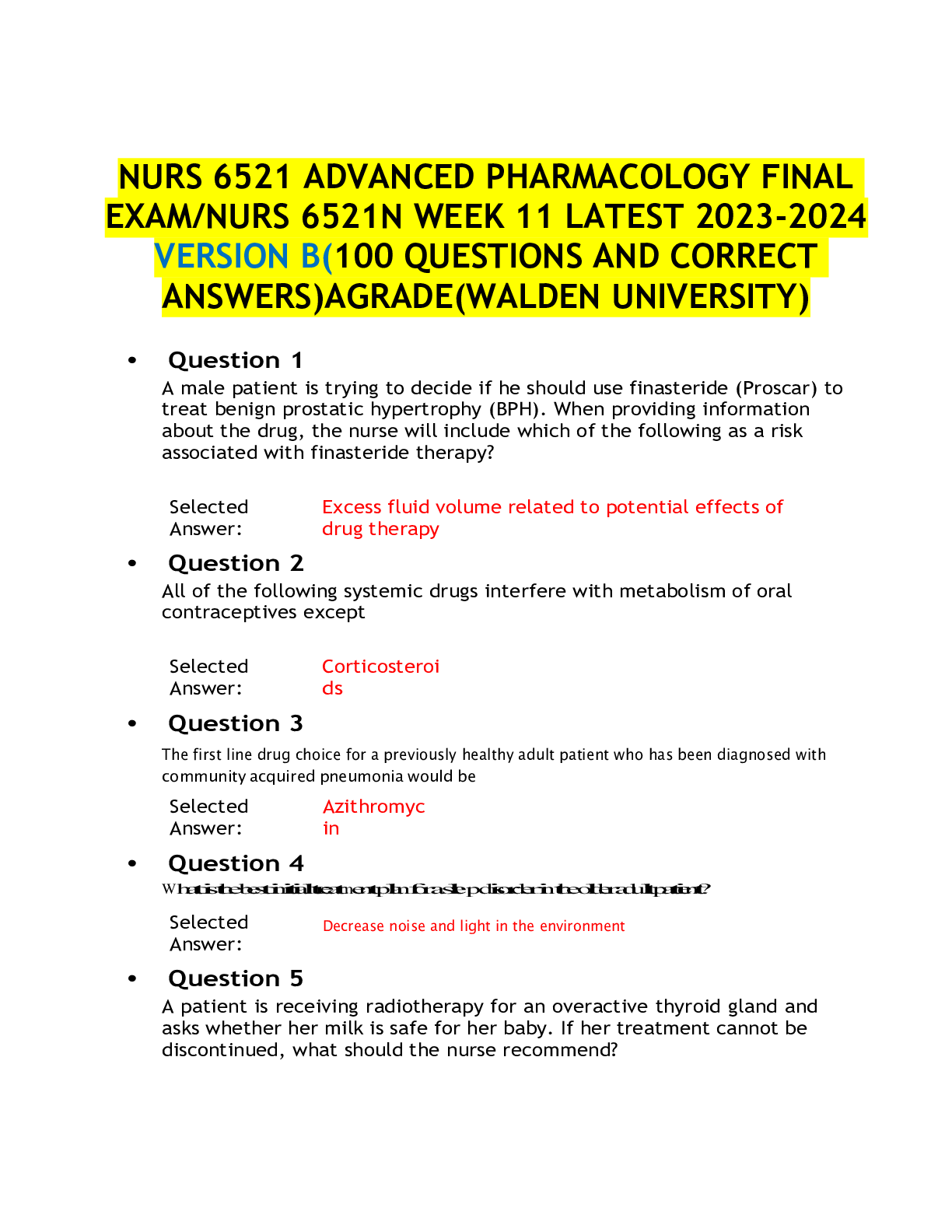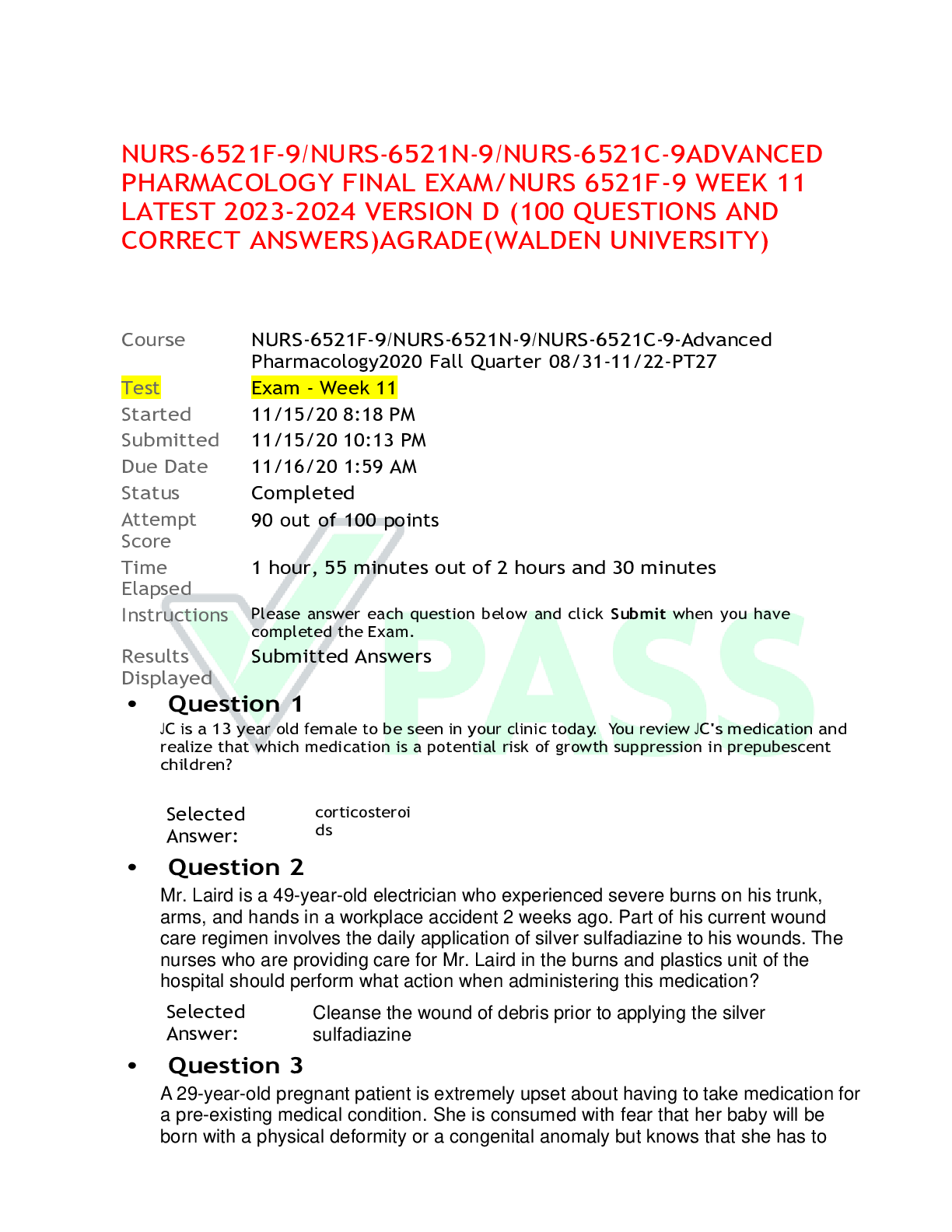*NURSING > EXAM > AGNP BOARD EXAM: Dermatology Prescription (100 Questions and Answers),100% CORRECT (All)
AGNP BOARD EXAM: Dermatology Prescription (100 Questions and Answers),100% CORRECT
Document Content and Description Below
Systemic ivermectin (Stromectol), classified as an antiparasitic,: is primarily excreted in the urine. crosses the blood-brain barrier. has a high concentration in the liver. is ... not well absorbed. Question: Topical permethrin (Elimite) in the treatment of scabies should be left in place for a minimum of: 30 minutes. 2 hours. 6 hours. 8 hours. Question: The mechanism of action of clindamycin (Cleocin), used in the treatment of cellulitis, is to: block synthesis of folic acid by bacteria and inhibit replication. uncouple mitochondrial oxidative metabolism and inhibit cell growth. block the dissociation of peptidyl tRNA from ribosomes. inhibit protein synthesis by preventing ribosomal translocation. Question: Tretinoin topical (Retin-A) is indicated for the treatment of acne vulgaris and: acne rosacea. dermatomyositis. inflammatory keratosis pilaris. mottled hyperpigmentation. Question: The brand name of oral isotretinoin is: Duac. Absorica. Accolate. Accupril. Question: Benzoyl peroxide (Benzac wash) is classified as a topical: antibiotic. astringent. antimicrobial. acetic acid-based cleanser. Question: The generic name for Elidel is: permethrin. pimecrolimus. tacrolimus. urea topical. Question: Which of the following conditions is NOT a side effect of long-term use of topical steroids? Cutaneous atrophy Glaucoma Hypotrichosis Telangiectasia Question: Patients using fluorouracil (Carac) for the treatment of actinic keratosis should be advised to expect: hypopigmentation. eczema. pustular formation. vesiculation. Question: Tetracycline (Sumycin) is used in the treatment of skin and skin structure infections caused by: Bartonella bacilliformis. Klebsiella species. Escherichia coli. Staphylococcus aureus. Question: The most appropriate therapy for patients with chronic paronychia is a: systemic antifungal. systemic glucocorticoids. topical steroid. topical antibiotic. Question: The use of tetracycline in children younger than 9 years with a bacterial skin infection, may cause: dental enamel hyperplasia. hypopigmentation. serum sickness. reduced bone growth. Question: Daily doses of oral corticosteroids, such as prednisone, should be administered: early in the morning. at noon. with dinner. at bedtime. Question: The mechanism of action of sulfa agents, in the treatment of cellulitis, is to: block synthesis of folic acid by bacteria and inhibit replication. uncouple mitochondrial oxidative metabolism and inhibit cell growth. block the dissociation of peptidyl tRNA from ribosomes. inhibit protein synthesis by preventing ribosomal translocation. Question: Topical salicylic acid, a keratolytic: can be used for genital warts. should be applied once weekly. is safe for use on the face. should not be used in areas with poor blood circulation. Question: Retapamulin (Altabax), used in the treatment of impetigo, is NOT: a topical antibiotic. effective against Streptococcus pyogenes. to be applied intranasally or to mucosa. for use in children. Question: Initial treatment for irritant contact dermatitis is a: low-potency topical steroid. medium-potency topical steroid. high-potency topical steroid. super high-potency topical steroid. Question: The brand name of clindamycin and benzoyl peroxide topical for the treatment of acne is: Cleocin T. Desonate. Duac. Benzamycin. Question: Dosage reductions should be considered when prescribing first-generation cephalosporins for patients with: hepatic insufficiency. diabetes. cardiomyopathy. renal insufficiency. Question: Diclofenac (Solaraze), a topical anti-inflammatory, is used in the treatment of: actinic keratosis. acne vulgaris. contact dermatitis. eczema. Question: Antiviral agents for the treatment of herpes zoster: are most effective when started within 48-72 hours of outbreak. should not be initiated after 72 hours. do not prevent postherpetic neuralgia. do not reduce the risk of transmission of the virus through shedding. Question: A side effect of benzoyl peroxide (Benzac wash) is: hyperpigmentation. bleaching of eyebrows. oily skin. hypopigmentation. Question: Which of the following is NOT appropriate advice for the patient using benzoyl peroxide (Benzagel)? Discontinue use for mild peeling or redness Avoid the use of tanning beds Wear sunscreen Test skin in 1-2 small areas prior to full use Question: Clindamycin (Cleocin) should NOT be administered with: buspirone (Buspar). erythromycin (Ilotycin). rifampin (Rifadin). ibuprofen (Advil). Question: Moderate irritant contact dermatitis to the face should be treated with a: medium-potency topical steroid. high-potency topical steroid. super high-potency topical steroid. oral corticosteroids. Question: Patients treated with sulfamethoxazole and trimethoprim (Bactrim) should be advised to take it: with 8 ounces of water. with food. on an empty stomach. with folic acid. Question: A breastfed infant has been diagnosed with oral candidiasis. Which of the following statements is true? Do not feed the infant for at least 1 hour after application of nystatin oral suspension. Nystatin oral suspension is not for prolonged use and should not be administered for more than 3-5 days. The mother should be treated prophylactically with fluconazole (Diflucan). Treatment with nystatin oral suspension should be continued for at least 48 hours after symptoms have disappeared. Question: Fluorouracil (Carac), for treatment of actinic keratosis, is classified as a(n): anti-inflammatory. antibiotic. antineoplastic. steroid. Question: Ciclopirox (Loprox) shampoo for the treatment of seborrheic dermatitis should be applied: daily. twice daily. weekly. twice weekly. Question: Which of the following antibiotics is NOT approved for the treatment of acne vulgaris? Azithromycin (Zithromax) Doxycycline (Doryx) Metronidazole (Flagyl) Trimethoprim-sulfamethoxazole (Bactrim DS) Question: The greatest concern with long-term use of topical corticosteroids is: purpura. rosacea-like eruptions. acneiform eruptions. skin atrophy. Question: Patients with comedonal noninflammatory acne should be treated with a topical: retinoid. antibiotic. antimicrobial. antimicrobial/antibiotic combination. Question: Dynacin, used in the treatment of skin infections, is the brand name for: tetracycline. doxycycline. minocycline. demeclocycline. Question: Tretinoin topical gel (Atralin) should be used cautiously in patients who are allergic to: eggs. peanuts. fish. strawberries. Question: A patient received a prescription for clindamycin/benzoyl peroxide topical with orders to dispense 2 containers. Until ready for the use, the patient should store the additional container: in the freezer. at room temperature. in the refrigerator. in a warm, dry place. Question: Given the same percentage and type of topical corticosteroid, the vehicle with the highest potency would be the: cream. lotion. ointment. gel. Question: Patients should be advised that clindamycin (Cleocin) should be administered with: a full glass of water. lactobacillus. food. milk. Question: The body surface area with the LEAST ability to absorb topical steroids is: the axillae. the face. the groin. the palms. Question: The most troublesome adverse reaction to clindamycin (Cleocin), used in the treatment of cellulitis, is: esophageal ulcerations. nephrotoxicity. Clostridium difficile-related colitis. photosensitivity. Question: The best treatment for mild cellulitis caused by methicillin-resistant Staphylococcus aureus is: topical mupirocin (Bactroban). oral amoxicillin/clavulanate (Augmentin). oral trimethoprim-sulfamethoxazole (Bactrim). oral cephalexin (Keflex). Question: The preferred treatment for Lyme disease in a 16-year-old male is: amoxicillin (Amoxil). azithromycin (Zithromax). clarithromycin (Biaxin). doxycycline (Vibramycin). Question: The most effective way to assure that the patient has enough topical corticosteroid for the duration of treatment is to: give the largest tube available. give one refill for every 2 days of use. determine the amount needed using the fingertip unit (FTU). determine the amount based on 0.1 grams per square inch needed to cover. Question: Which of the following medications for the treatment of acne is extended-release and is dosed according to weight? Rifampin (Rifadin) Metronidazole (Flagyl) Clindamycin (Cleocin) minocycline (Minocin) Question: To assure maximum efficacy in the treatment of actinic keratosis, fluorouracil (Carac) should be applied for at least: 4 days. 4 weeks. 6 weeks. 8 weeks. Question: A 23-year-old man has completed 12 weeks of therapy with clindamycin/benzoyl peroxide topical for acne. He should be advised to return immediately if he develops: dizziness. xeroderma. abdominal pain and diarrhea. muscle pain and weakness. Question: Due to potential systemic absorption, the use of fluorouracil (Carac) should be avoided in patients who: have anemia. are pregnant. have renal insufficiency. have a history of seizures. Question: Topical corticosteroids, used to treat various skin conditions,: do not suppress the immune system. possess anti-inflammatory properties. do not cause systemic side effects. are safe to use during pregnancy. Question: Patients should be advised that after an intralesional corticosteroid injection, they should expect: swelling, redness and warmth in the area. possible hyper- or hypopigmentation. complete resolution of the lesion within 1 week. sloughing of the skin. Question: Imiquimod (Aldara) is indicated for the treatment of: acne. actinic keratosis. erysipelas. keloids. Question: Benzoyl peroxide (Benzagel) is indicated for the treatment of: hyperpigmentation. mild acne and rosacea. dermatomyositis. severe acne vulgaris. Question: Patients using diclofenac (Solaraze) should be advised to expect optimal therapeutic effect of actinic keratoses within: 2 weeks of continuous application. 4 weeks of continuous application. 6 weeks of continuous application. 1 month following cessation of therapy. Question: Which statement about the action of silver sulfadiazine (Silvadene) cream is TRUE? It acts by inhibiting cell wall synthesis. It is a carbonic anhydrase inhibitor. It inhibits folic acid synthesis. It acts by damaging the cell membrane and cell wall. Question: A potential systemic reaction to imiquimod (Aldara), used to treat superficial basal cell carcinomas, is: bradycardia. hypoglycemia. flu-like symptoms. renal calculi. Question: Patients with seborrheic dermatitis who have patchy, orange to salmon-colored plaques covered with scales should be treated with: topical antihistamines in combination with antifungal shampoo. a high-potency corticosteroid shampoo. systemic glucocorticoids. systemic antifungals. Question: Intralesional corticosteroid injections should NOT be: diluted with lidocaine, a local anesthetic. injected into the dermis. injected into the subcutaneous tissue. utilized for lesions in thin skinned areas such as the face. Question: Laboratory monitoring for a patient on cephalexin (Keflex) should include: urine microalbumin. PT/INR. amylase. electrolytes. Question: Prednisolone topical cream belongs to which of the following drug classes? Anabolic steroids Androgenic steroids Glucocorticoids Mineralocorticoids Question: Silver sulfadiazine (Silvadene) cream, indicated for the treatment of burns, is: bacteriostatic. a broad-spectrum antimicrobial. only a prophylactic measure to prevent infection. not recommended for third-degree burns. Question: The use of silver sulfadiazine (Silvadene) cream should be avoided in: patients older than 75 years. the presence of renal insufficiency. areas where skin grafting may be needed. pregnant women during the third trimester. It is not contraindicated in areas that may require grafting. Patients with renal insufficiency should be monitored closely. Question: Dapsone (Aczone) topical 5% gel should be applied: daily in a dime-sized amount. twice daily in a nickel-sized amount. daily in a thumb-sized amount. twice daily in a pea-sized amount. Question: The recommended first-line treatment of tinea capitis in a 5-year-old child is: griseofulvin (Grifulvin V). fluconazole (Diflucan) systemic. ketoconazole (Nizoral) shampoo. moderate-dose topical steroids. Question: Patients applying low-potency steroids to the face should be instructed to: apply 2-3 fingertips of the medication once daily for 7 days. apply a thin film 2-3 times daily for 7 days. discontinue use if changes in skin color appear. discontinue use after 6 weeks even if the condition continues. Question: Lidocaine (Lidoderm) patch should NOT be prescribed for patients allergic to: benzocaine (Anbesol). bupivacaine (Marcaine). tetracaine (Pontocaine). diphenhydramine (Dermarest). Question: Topical permethrin should be avoided in patients with an allergy to: milk. peanuts. ragweed. strawberries. Question: The most effective therapies in the treatment of acne related to increased sebum production are: benzoyl peroxide and topical antibiotics. benzoyl peroxide and oral antibiotics. oral tetracyclines and topical retinoids. hormonal therapies and isotretinoin. Question: A potential adverse reaction related to the use of sulfacetamide (Klaron) topical, indicated for the treatment of seborrheic dermatitis, is: systemic lupus erythematous. skin irritation. localized infection. renal insufficiency. Question: The addition of epinephrine to lidocaine hydrochloride: causes vasodilation. prolongs the duration of anesthesia. reduces microorganism penetration. decreases the pain of the anesthetic injection. Question: High-potency topical corticosteroids: can be applied to the face. may be absorbed and cause systemic side effects. may cause hypoglycemia. may cause hypotension. Question: First-generation cephalosporins for the treatment of bacterial skin infections: have a decreased risk of cross-reactivity in penicillin allergic patients in comparison to other cephalosporins. have broad coverage against both gram-positive and gram-negative organisms. primarily are effective against gram-positive organisms. mostly decrease activity against gram-negative organisms. Question: Which of the following is NOT a topical pediculicide? Benzyl alcohol (Ulesfia) Ivermectin (Stromectol) Permethrin (Elimite) Selenium sulfide (Selsun Blue) Question: Pediatric patients are at greater risk than adults for developing adrenal suppression related to topical steroid use due to their: higher metabolism. decreased lean muscle mass. higher ratio of skin surface area to body mass. lower basal cortisol rates. Question: The patient receiving imiquimod (Aldara) topical for the treatment of actinic keratosis should be instructed to apply: daily for a maximum therapy duration of 16 weeks. daily, as long as it takes to resolve the lesions. every other day until lesions are resolved. twice weekly for maximum of 16 weeks. Question: A combination topical antimicrobial-antibiotic medication used in the treatment of acne is: benzoyl peroxide and erythromycin. benzoyl peroxide and adapalene. benzoyl peroxide and tretinoin. benzoyl peroxide and dapsone. Question: Children receiving griseofulvin (Grifulvin V) for the treatment of tinea capitis should be monitored for: alopecia. clay-colored stools. tinea versicolor. tinnitus. Question: Which of the following statements about systemic clindamycin (Cleocin) is true? Dialysis is effective in removing clindamycin (Cleocin) from the serum. Clindamycin (Cleocin) adequately diffuses into the cerebrospinal fluid and is effective for the treatment of meningitis. Colitis related to clindamycin (Cleocin) may occur more than 2 months after cessation of therapy. Clindamycin (Cleocin) is safe to prescribe to atopic patients. Question: Sulfamethoxazole and trimethoprim (Bactrim) should NOT be prescribed for patients who: have megaloblastic anemia due to folic acid deficiency. have mild to moderate renal insufficiency. are between the ages of 2-6 years. have bronchial asthma. Question: The best medication choice for the treatment of acne in hairy areas is: clindamycin topical cream (Cleocin T). clindamycin topical lotion (Cleocin T). benzoyl peroxide/clindamycin gel (Clindagel). clindamycin phosphate (Clindamycin Foam). Question: An example of a first-generation cephalosporin is: cefixime (Suprax). ceftriaxone (Rocephin). ceftaroline (Teflaro). cephalexin (Keflex). Question: The half life of trimethoprim-sulfamethoxazole (Bactrim DS) is approximately: 4 hours. 6 hours. 10 hours. 12 hours. Question: Zinc oxide is indicated in the treatment of: dermatophytosis. diaper dermatitis. animal bites. puncture wounds. Question: A treatment regimen for acne will only be considered ineffective after consistent adherence for at least: 2 weeks. 4 weeks. 6 weeks. 8 weeks. Question: Severe nodular acne should be treated with: oral isotretinoin monotherapy. topical retinoid and topical benzoyl peroxide. topical retinoid and oral isotretinoin. a topical retinoid, benzoyl peroxide and a topical antibiotic. Question: Patients receiving imiquimod (Aldara) should not receive: fluoroquinolones. live vaccines. oral steroids. tetracyclines. Question: Zinc oxide, for the treatment of diaper dermatitis, is classified as a(n): antimicrobial. antifungal. bacteriostatic agent. skin barrier. Question: Instructions given to patients being treated with Silver sulfadiazine (Silvadene) cream should NOT include: apply with sterile gloves. cover with a dressing after applying the cream. apply immediately after debridement. apply to the face. Question: A patient with psoriasis has a salicylic acid sensitivity and should be instructed to avoid: soy milk. bananas. almonds. white potatoes. Question: The initial recommended therapy for patients with moderate postherpetic neuralgia is: capsaicin cream (Capsagel). gabapentin (Neurontin). hydrocodone and acetaminophen (Norco). diphenhydramine (Dermarest). Question: Capsaicin topical cream, used to relieve pain related to herpes zoster,: is used to debride open wounds and blisters. may cause extreme irritation to eyes and mucous membranes. should be used with a heating pad. is derived from banana peppers. Question: The steps to correctly apply topical permethrin (Nix) in the treatment of pediculosis capitis is to: 1. Apply to dry hair, devoid of conditioner. 2. Leave in place for 10 minutes. 3. Rinse with warm water over the sink. 4. Repeat treatment 7 days later if needed. 1. Apply to wet hair. 2. Leave in place for 30 minutes. 3. Rinse with warm water over the sink. 4. Repeat treatment 3 days later if needed. 1. Apply to wet hair that has been conditioned. 2. Leave in place for 15 minutes. 3. Rinse with warm water in the shower. 4. Repeat treatment 7 days later if needed. 1. Apply to dry hair sparingly. 2. Leave in place for 30 minutes. 3. Rinse with warm water in the shower. 4. Repeat treatment 14 days later if needed. Question: When administering cephalexin (Keflex) suspension, sometimes used in the treatment of acne vulgaris,: administer the suspension with food. administer it at bedtime. refrigerate the suspension. leave the suspension at room temperature. Question: The mechanism of action of oral antifungal agents, used in the treatment of tinea corporis, is to: block synthesis of folic acid by bacteria and inhibit replication. uncouple mitochondrial oxidative metabolism and inhibit cell growth. block the dissociation of peptidyl tRNA from ribosomes. inhibit protein synthesis by preventing ribosomal translocation. Question: Oral antibiotics for the treatment of acne vulgaris: should not be used as monotherapy. must be tapered slowly to discontinue. are indicated as initial treatment. are used as maintenance therapy. Question: The best choice for the relief of painful oral lesions associated with hand foot and mouth disease in children is: topical lidocaine. topical anesthetics. diphenhydramine suspension and Maalox mixed. oral acetaminophen. Question: Imiquimod (Aldara) is classified as a topical: anti-inflammatory. antibiotic. antineoplastic. steroid. Question: Pimecrolimus (Elidel) is classified as a topical: antineoplastic. calcineurin inhibitor. corticosteroid. keratolytic. Question: Gabapentin (Neurontin), indicated in the treatment of postherpetic neuralgia,: is highly protein bound. has dose proportional bioavailability. is metabolized into a prodrug. is excreted unchanged in the urine. Question: The Fingertip Unit (FTU) method is used when prescribing topical medications. If one arm equals 3 fingertips, approximately how many grams will need to be prescribed for a man who needs BID application to one arm for 7 days? 15 grams 21 grams 30 grams 60 grams Question: To enhance absorption, tetracycline should be administered: with milk. on an empty stomach. with food. with an antacid. Question: Pimecrolimus (Elidel) is indicated in the treatment of: actinic keratosis. acne vulgaris. atopic dermatitis. psoriasis. Question: The generic name for Mycostatin is: atorvastatin. fluvastatin. nystatin. pravastatin. [Show More]
Last updated: 1 year ago
Preview 1 out of 52 pages
Instant download
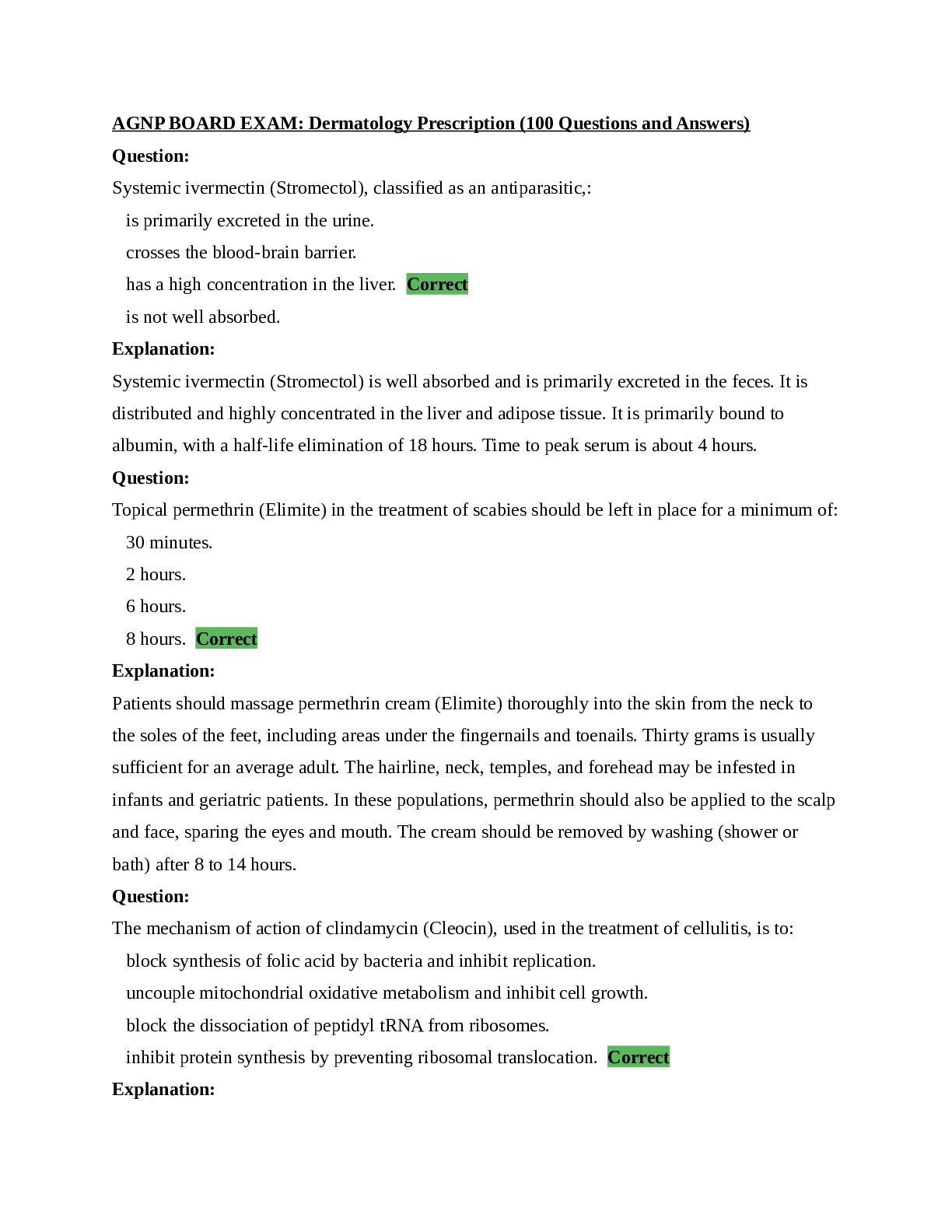
Instant download
Also available in bundle (1)
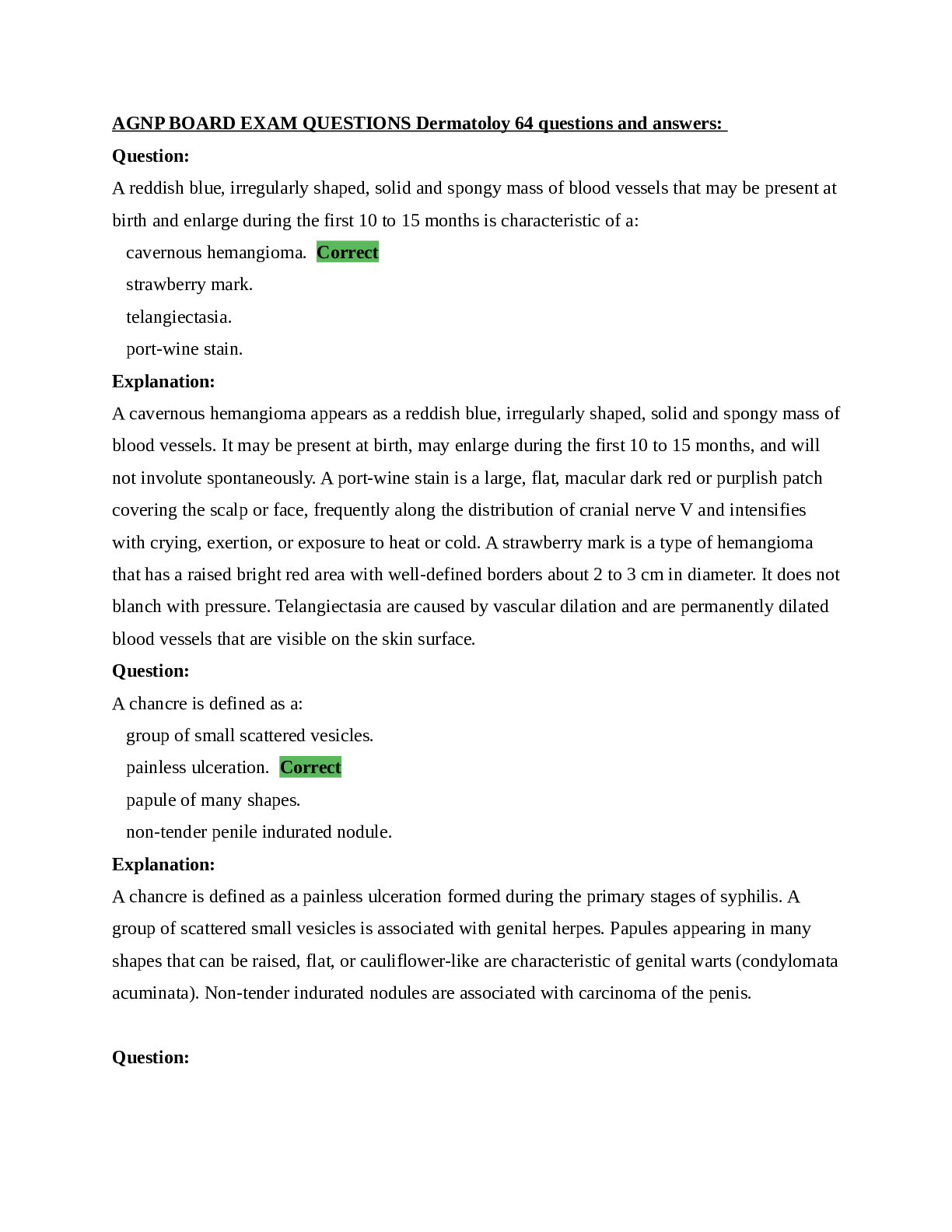
AGNP BOARD EXAM: Dermatology Prescription&AGNP BOARD EXAM QUESTIONS Dermatoloy 64 questions and answers,100% CORRECT
AGNP BOARD EXAM QUESTIONS Dermatoloy 64 questions and answers/AGNP BOARD EXAM: Dermatology Prescription
By securegrades 3 years ago
$24.5
2
Reviews( 0 )
Document information
Connected school, study & course
About the document
Uploaded On
Jan 20, 2021
Number of pages
52
Written in
Additional information
This document has been written for:
Uploaded
Jan 20, 2021
Downloads
0
Views
42




















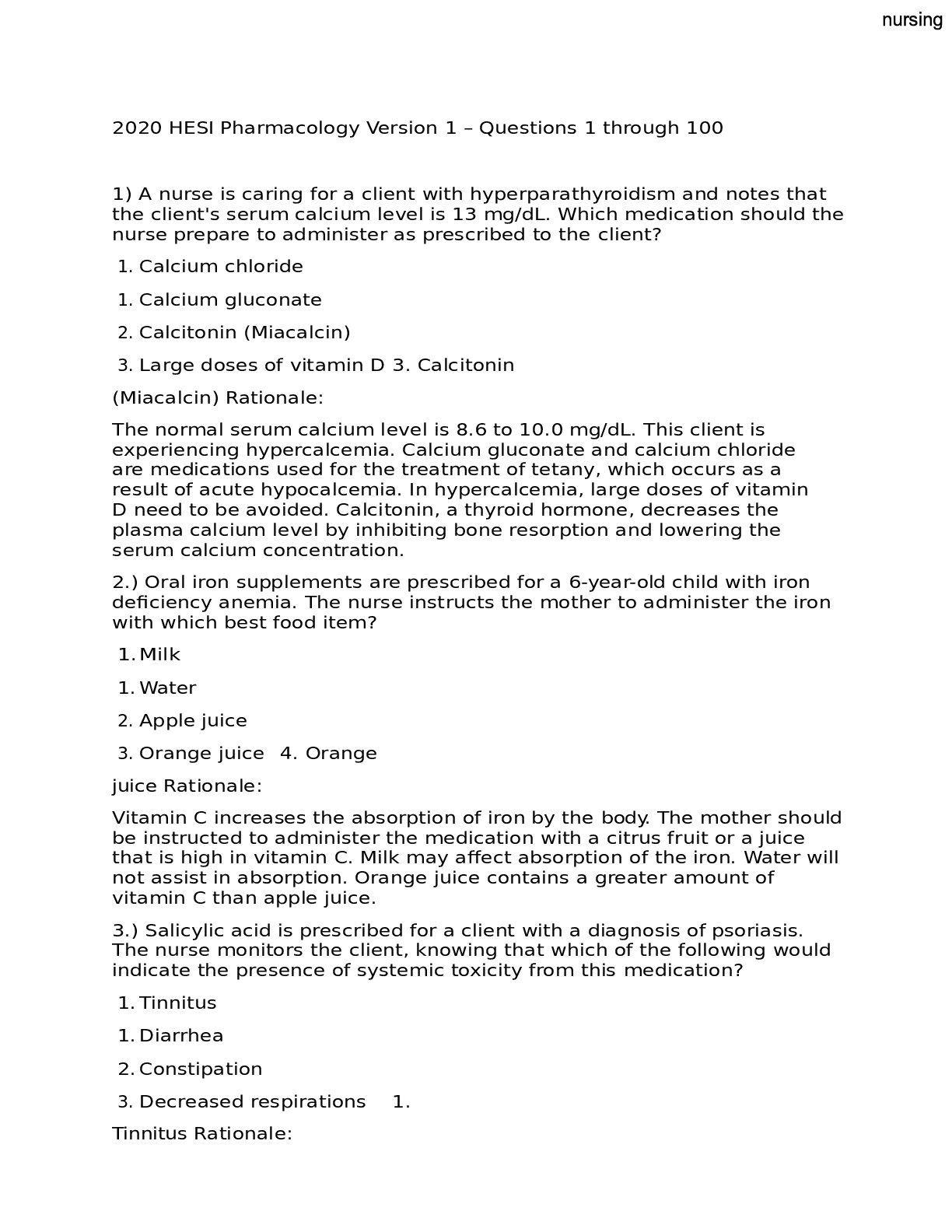
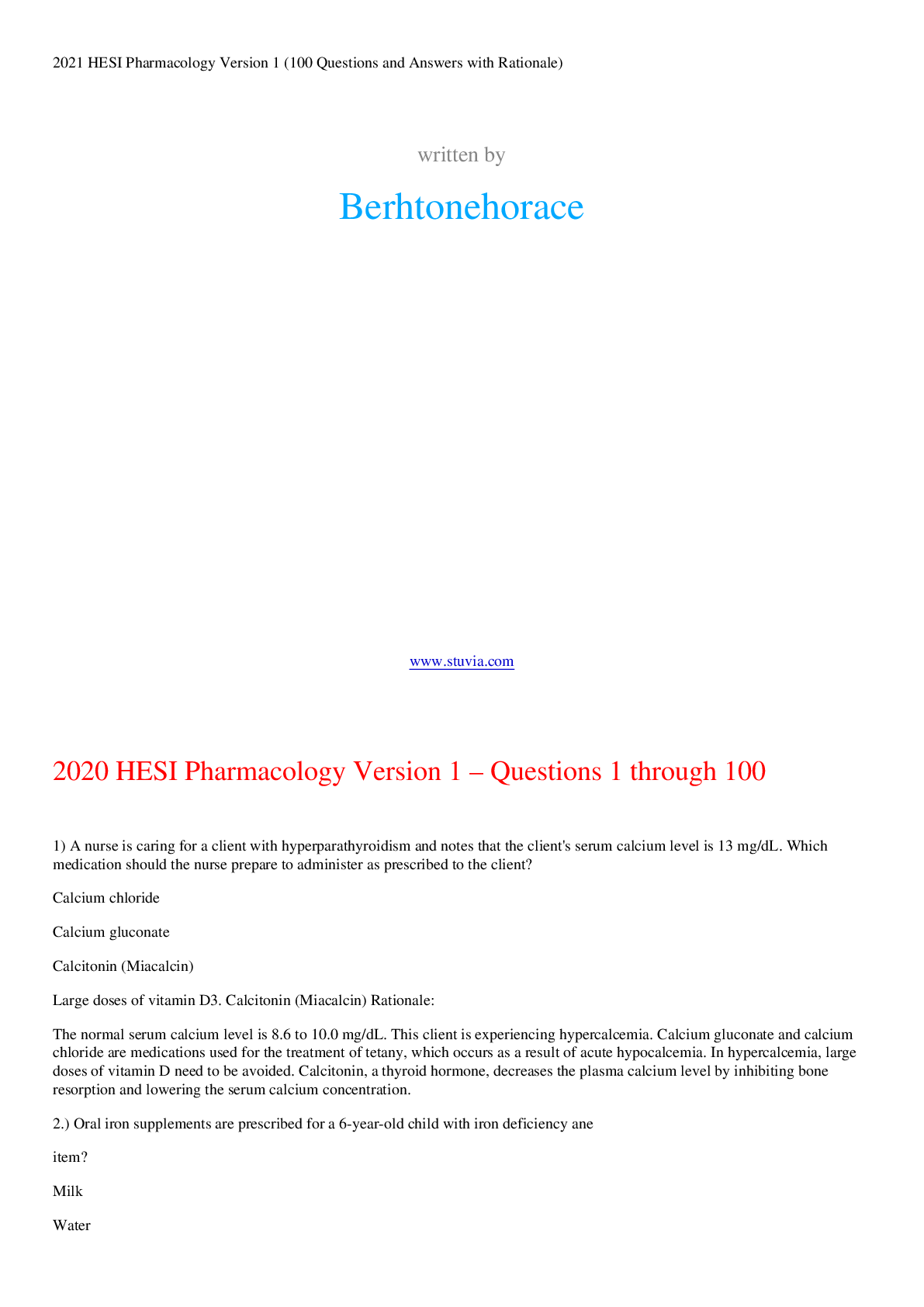
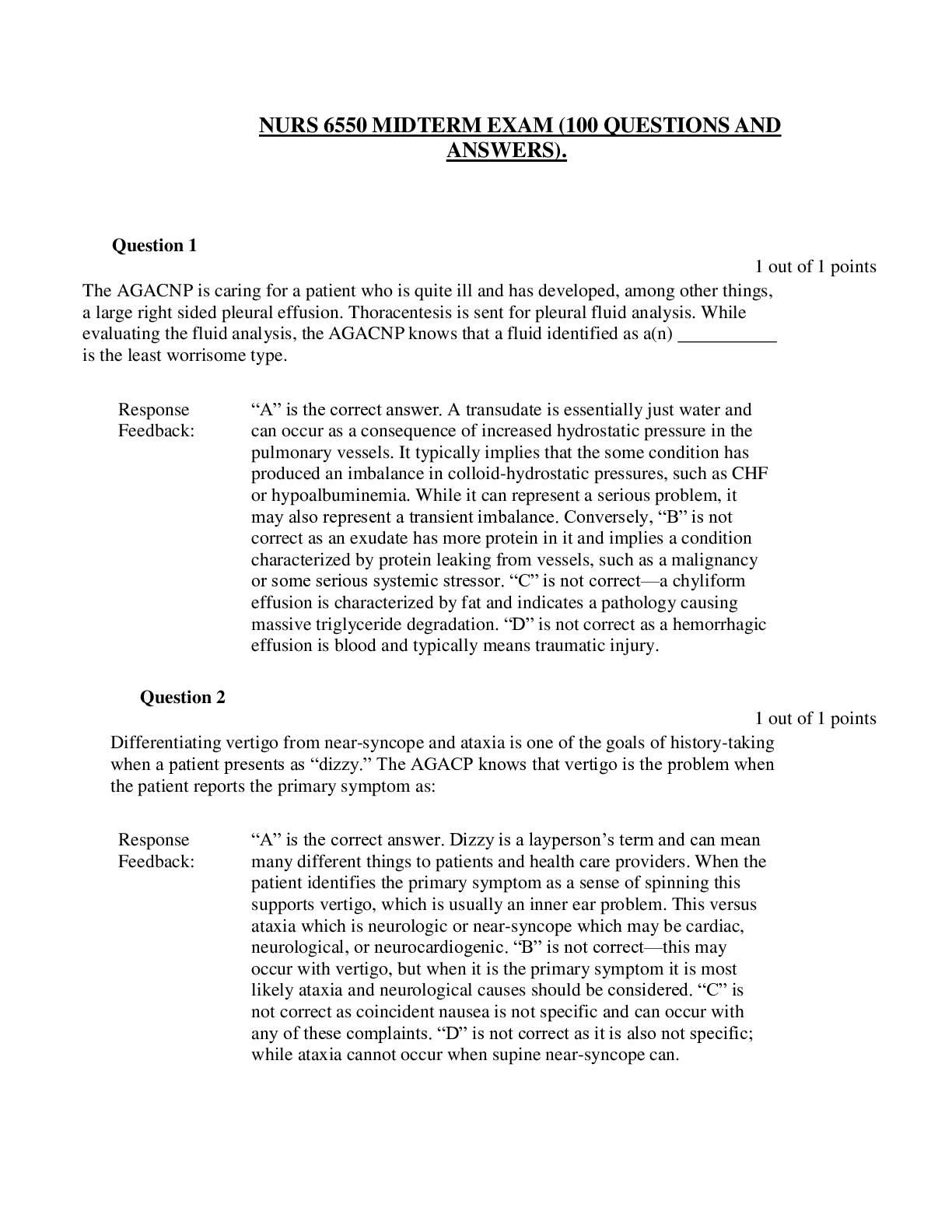
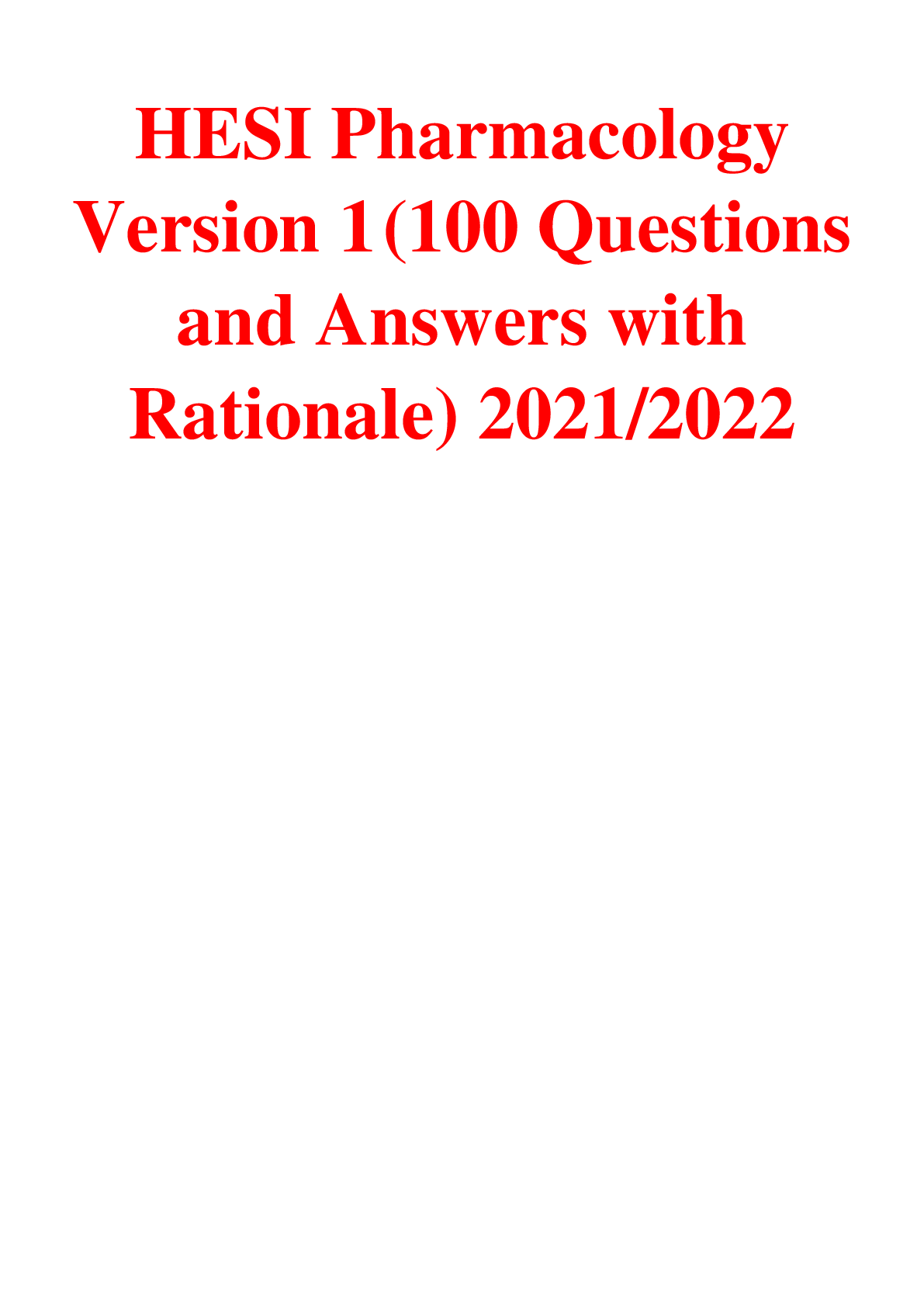
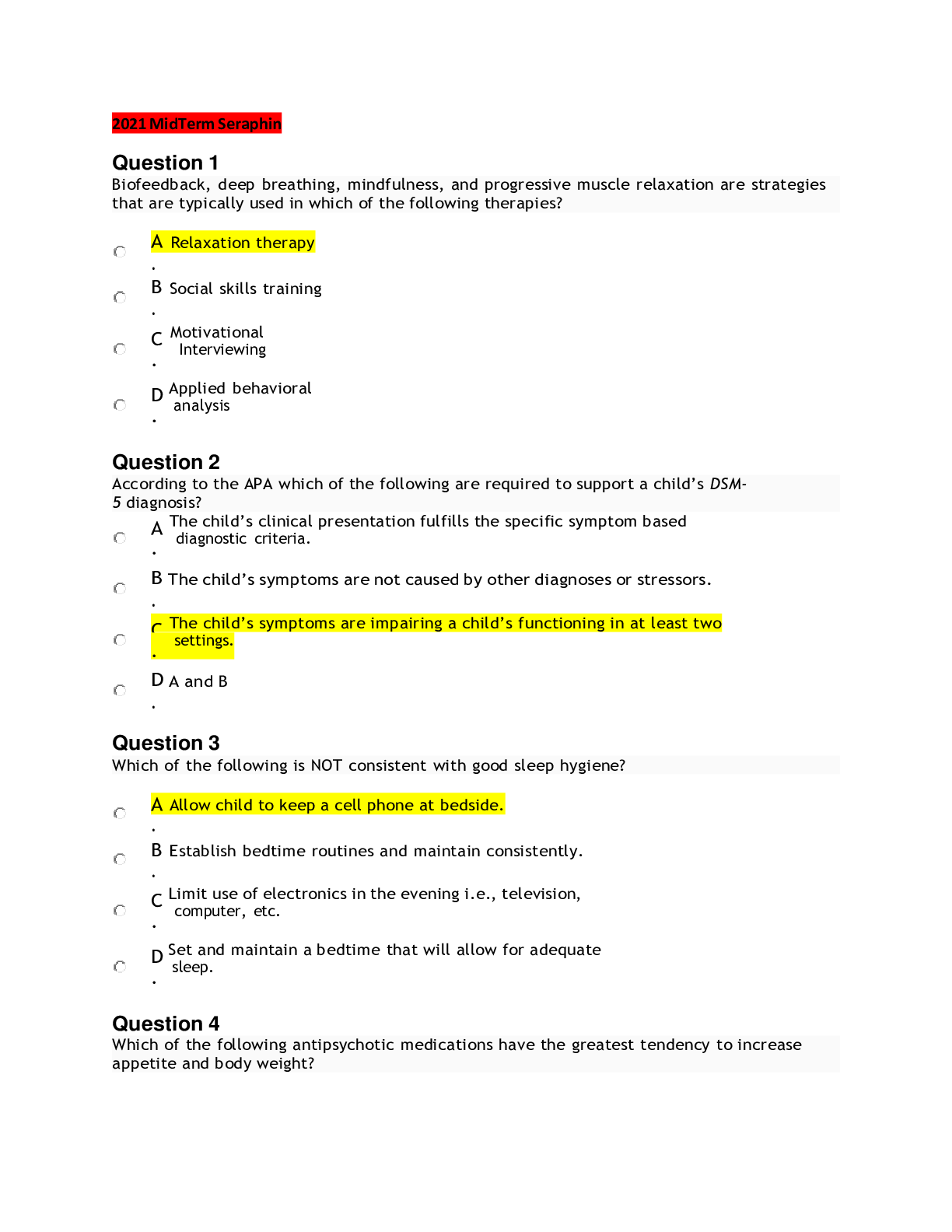
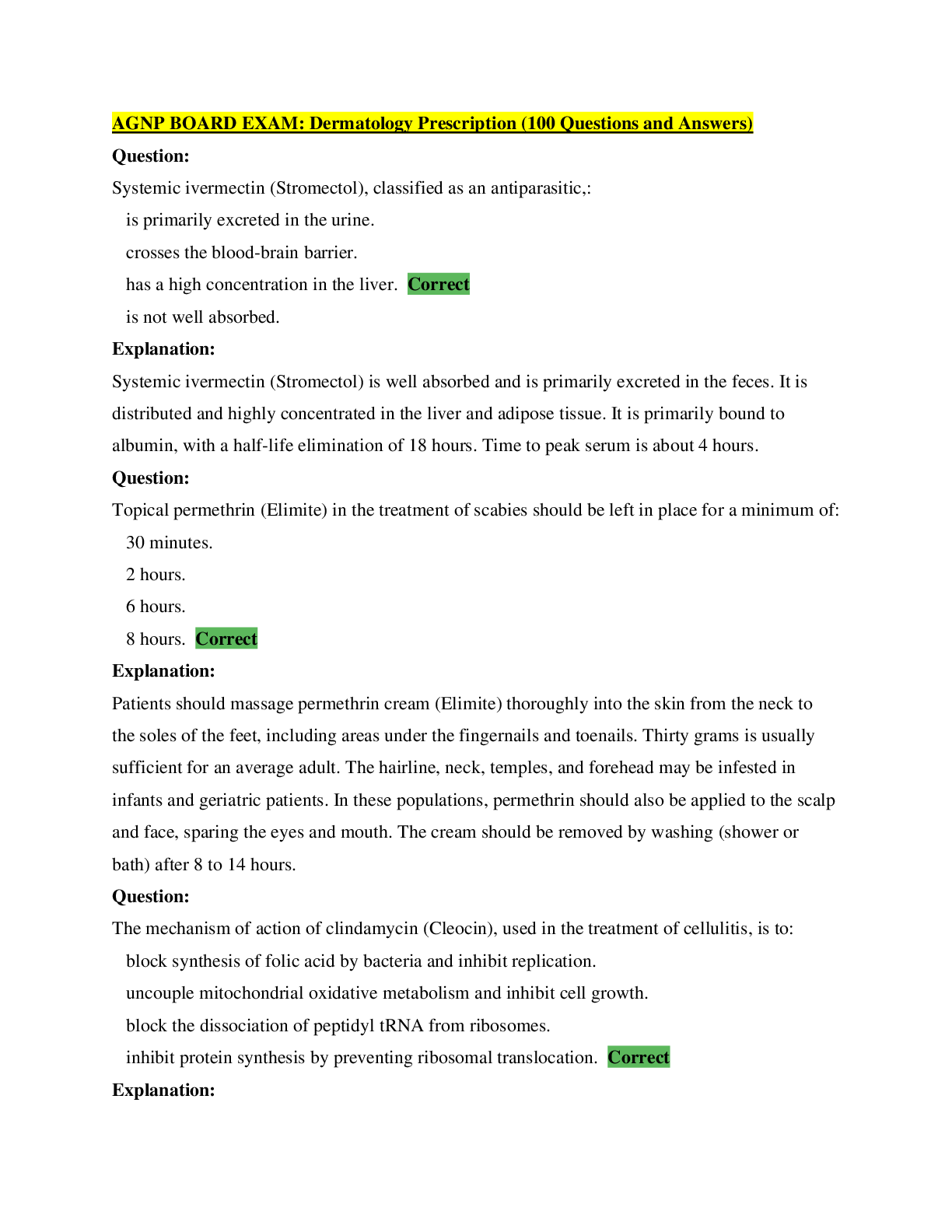

 _ Dermatology Prescription (100 Questions and Answers) – South University Savannah.png)


